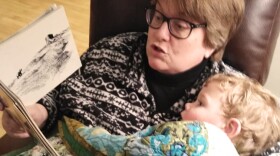In 1977 Sue Leaf attempted a bike trip up the South Shore of Lake Superior with her boyfriend (now husband). The physical demands of biking the hills cut the trip short, but not before Leaf fell in love with the coast of the lake.
In a recent What We’re Reading interview, Leaf recounted the first morning of the trip.
“We'd set up the tent in the dark and then we went to bed and then first morning I woke up and I looked out the tent and I could not believe my eyes, that there was just we were so close to Lake Superior and there were no rocks. It was all sand. It was a beautiful sand beach.”
Leaf shares her personal stories and the natural history of Lake Superior’s South Shores in her new book Impermanence: Life and Loss on Superior’s South Shore.
Many of us in Northern Minnesota are likely familiar with the rocky cliffs, waterfalls, and clear sparkling waters of Lake Superior's North Shore. But Leaf noted the geological differences between the two shores: the North Shore being volcanic in origin and the South Shore glacial sediment and red clay.
Leaf also explained that since the glaciers retreated 11,000 years ago, the shores of the Lake Superior's southern coast have been eroding by increments as a “natural erosive process.”
But the erosion is noticeably increasing.
When Leaf and her husband bought a cabin and property on Superior’s South Shore in 1988, the seller told them to expect erosion of about a foot of shoreline per year—an amount they thought they could handle.
They saw a foot and a half of erosion per year for the past 30 years as expected. But conditions on the lake became more extreme. Leaf noted that recently with “rains and extraordinarily high lake levels, we suffered 28 feet of erosion in a 3-year time period.”
Situated between the shore and the cabin, their well was now dangerously close to a cliff. Leaf and her husband came to a realization that they never thought they’d have to worry about: the cabin could go into the lake in their lifetime.
“[It] is one of the fastest changing lakes in the world with respect to climate change."Writer Sue Leaf on Lake Superior
Lake Superior has not been immune to climate change. Leaf explained, “[It] is one of the fastest changing lakes in the world with respect to climate change. The temperature is going up and we can feel that. When we first started swimming in the lake in the late 1980s in August, 10 minutes was as much as we could stand. It was really cold. And now it's very comfortable swimming in August. We have no trouble at all.”
She also noted that with the rise of temperature in the lake, the South Shore is already seeing algal growth where none was before. This will affect the food chain and the fish that thrive in the cold waters of the lake.
Leaf considered several options for dealing with her family's cabin on the lake, from building up the shoreline to just walking away from the property. They eventually decided to build a new cabin farther away from the shore.
Leaf realized that if she walked away from the property, she would lose that relationship with the lake--something she wasn’t ready for.
“I can be put into a very contemplative frame of mind when I'm looking out over the horizon of the lake. That's one of the reasons we wanted to be on Superior rather than a smaller lake. [The] perception of eternity as you look out over the water.”
Sue Leaf’s new book is Impermanence: Life and Loss on Superior’s South Shore, published by the University of Minnesota Press.
Looking for a good book recommendation? Want to recommend a book you've just read? Check out our What We're Reading page on Facebook, or text us at 218-326-1234.
What We're Reading is made possible in part by the Arts and Cultural Heritage Fund and the citizens of Minnesota.














